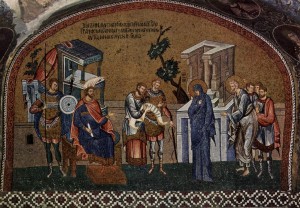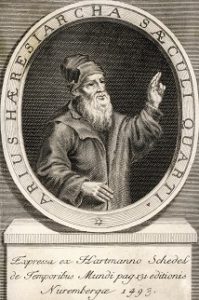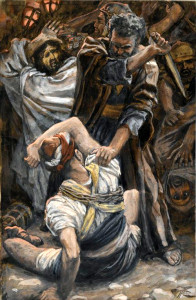 The Historical Argument represents the sixth step in Logic & Light’s systematic case for the Christian God. It seeks to demonstrate, using sound historical facts from both biblical and extra-biblical testimony, that Jesus was divine and actually resurrected after His crucifixion. If the fact of Jesus’ resurrection is established, then Christianity is, without a doubt, true. We have addressed one form of the Historical Argument previously (Six Facts About Jesus: Part I, Part II, Part III), but we will cover a bit more ground here. Continue reading
The Historical Argument represents the sixth step in Logic & Light’s systematic case for the Christian God. It seeks to demonstrate, using sound historical facts from both biblical and extra-biblical testimony, that Jesus was divine and actually resurrected after His crucifixion. If the fact of Jesus’ resurrection is established, then Christianity is, without a doubt, true. We have addressed one form of the Historical Argument previously (Six Facts About Jesus: Part I, Part II, Part III), but we will cover a bit more ground here. Continue reading
Category Archives: Historical Reliability of the Bible
Arguments suporting the Bible’s reliability as a collection of historical documents, with a particular emphasis on the New Testament
Know Your Heresies
Many critics like to claim that the Christian faith we know today is not the earliest form of Christianity. Instead, they say there were many competing versions of Christianity in the first century—often with wildly diverging beliefs about God, Jesus, and salvation—that were all vying for supremacy. Over the centuries, the narrative goes, “orthodox” Christianity was the most aggressive form, suppressing all other forms and crowding them out. Therefore, they conclude, the Christian faith we know today is invalid. It just happened to be the “winner” among competing mythologies simply because its adherents were more aggressive, ruthless, and shrewd than those who followed other “Christianities.”
Three Points on Orthodoxy and Heresy
To put it simply, the narrative above is incorrect. Those who propagate it display an ignorance of history, an unwillingness to accept evidence, or a combination of both. When honestly assessing the history of Christianity, a few points become very clear: Continue reading
Who Wrote the Gospel of Mark?
The Christian church teaches that the gospels of Matthew, Mark, Luke, and John are accurate historical accounts of the teachings, death, and resurrection of Jesus. According to the church, these documents were written by direct eyewitnesses to the events recorded, or by people who captured the first-hand testimony of eyewitnesses.
Some argue that the gospels are not eyewitness accounts, but were instead compiled by anonymous editors several generations after the fact. However, significant evidence favors the church’s point of view. In this article, we explore the evidence for Mark’s gospel.
Who Was Mark and When Did He Write?
Contradictions (7): Cleansing the Temple
The gospels relate a key event in which Jesus cleansed the Jewish temple in Jerusalem, kicking out the money changers and merchants who he felt were defiling that sacred place. In the synoptic gospels (Matthew 21, Mark 11, and Luke 19), this event is portrayed as taking place at the end of Jesus’ ministry, shortly before his crucifixion.
However, John’s gospel (chapter 2) tells us that this event took place at the beginning of Jesus’ ministry. Critics cite this as an example of contradiction between the gospels, and assert that it demonstrates the gospels’ unreliability as historical documents. Continue reading
Busted (14): Mark’s “Error” Regarding Jewish Handwashing Rituals
 Critics are fond of claiming that the gospels are full of historical errors, and that they are therefore unreliable as historical documents. Today’s article focuses on an alleged error in Mark’s gospel. Let’s get started by allowing biblical scholar, Bart Ehrman, to enlighten us regarding Mark’s ineptitude as an historian:
Critics are fond of claiming that the gospels are full of historical errors, and that they are therefore unreliable as historical documents. Today’s article focuses on an alleged error in Mark’s gospel. Let’s get started by allowing biblical scholar, Bart Ehrman, to enlighten us regarding Mark’s ineptitude as an historian:
Mark 7:3 indicates that the Pharisees ‘and all the Jews’ washed their hands before eating, so as to observe ‘the tradition of the elders.’ This is not true: most Jews did not engage in this ritual.1
Busted (13): On Mark’s (& Matthew’s) Geographical Ineptitude
![]() In this short article, we tackle yet another alleged error in the Gospel of Mark (and address the same “error” in Matthew’s gospel, as well). Let’s dive right in by reading the first verse in question, Mark 10:1 (NIV):
In this short article, we tackle yet another alleged error in the Gospel of Mark (and address the same “error” in Matthew’s gospel, as well). Let’s dive right in by reading the first verse in question, Mark 10:1 (NIV):
Jesus then left that place [Capernaum, in Galilee] and went into the region of Judea and across the Jordan. Again crowds of people came to him, and as was his custom, he taught them.
Some critics have argued that this verse contains a geographical error because it says that Jesus went from Capernaum, across the Jordan, and into Judea. That’s impossible, we are told, because Judea is not actually across the Jordan river from Capernaum…They’re both on the same side of the river. Continue reading
Busted (11): The Nazareth Myth
To some people, the very idea of Jesus is apparently so threatening, that they will go to great lengths to pretend he never even existed. Some of the shoddiest biblical “scholarship” I have ever read defends the so-called “Jesus Myth” theory: The idea that Jesus never existed—or that he was just a normal guy around whom great myths were developed after his death. From Richard Carrier to Acharya S (a pseudonym for author Dorothy Murdock, apparently meaning “guru”), we get treated to numerous varieties of the Jesus myth. One element of the Jesus myth is the idea that Nazareth, Jesus’ home town, did not exist in his day. As this fringe argument goes: Nazareth didn’t exist, and so Jesus didn’t either. As evidence, they tell us that Nazareth is not mentioned in the Old Testament, the Talmud, or in other early rabbinic literature. Continue reading
Busted (10): Mark’s Bad Geography?
Throughout our ongoing Busted series, we’ve been exploring critics’ claims that the gospels are full of historical and geographical errors, and are therefore untrustworthy sources of information. So far, the gospel writers are coming out looking pretty good.
In today’s short article, we tackle a totally nit-picky, never-should-have-been-made accusation against Mark. The verse in Question is Mark 11:1 (ESV): Continue reading
Busted (9): The Census

Byzantine Mosaic (c. 1315) showing Joseph and Mary registering for the census before Quirinius. This demonstrates a common misunderstanding of what Luke’s text intended to communicate. Source: Wikimedia Commons.
As I write this article, Christmas is just a few days away. So, it’s only fitting that we study a part of the Christmas story that critics love to attack: The census. According to Luke’s gospel, Joseph and a very pregnant Mary travelled from Nazareth to Joseph’s home town of Bethlehem to be “registered” as part of a census decreed by Caesar Augustus. Here is the relevant passage, Luke 2:1-3 (ESV): Continue reading
Undesigned Coincidences 8: Malchus Loses an Ear
This is the eighth installment in our series on undesigned coincidences in the gospels, based on a presentation by Dr. Tim McGrew. For an introduction to undesigned coincidences and this series, go here.
Peter Fights to Defend Jesus
In this short post, we’ll look at an undesigned coincidence between the gospels of John and Luke. The gospel of John tells us that when the temple guards came to arrest Jesus, his disciple Peter drew a sword and attacked one of the high priest’s servants, cutting off his ear. Here’s the account in John 8:10-12 (NIV): Continue reading






